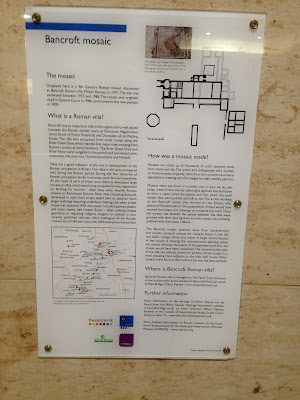It's nice to cycle up from our home in Furzton to Bancroft. The Redway follows the Loughton Brook, past some of the balancing lakes created to reduce flooding in that valley. Once past the concrete cows, the stream winds its way through Bancroft, with a footbridge linking to the western side - and the Roman Villa.
Fragments of Roman pottery were found by the stream fifty years ago. Major excavations took place between 1973 and 1978, directed by the Milton Keynes Archaeology Unit. Initially the site was backfilled and allowed to grass over. Then it was proposed in 1981 to create a full-size reconstruction of the villa at its most magnificent with a visitors centre and museum. Sadly these were the austerity 80s, and the ambitious plan was dropped. However further excavations were funded - covering an area of about 12,000 square metres.
The results of that excavation are set out in a two volume Monograph by R J Williams and R J Zeepat.
The earlier posts on Bronze Age and Iron Age Milton Keynes have already mentioned the settlement at Blue Bridge/Bancroft. It seems likely that the farmers there moved down the hill to the visible site of the villa. While the foundations of the main building are visible, the outbuildings lie buried underneath the open space between the roman remains and the pétanque piste to the north.
Where the Bronze and Iron Age settlement lay, a mausoleum was built. It continued in use, probably until the villa itself was abandoned in the fourth century CE (AD).
There are some excellent interpretation boards by the main villa building. The site was developed from the early years of the first century. We believe that the first farm (villa) on this site was constructed in the late first century. This was occupied until a fire destroyed mainly of the buildings in about 170 CE (AD). A large Roman style house was was built in the late third century - but there is no evidence that it was a farm. It was in the fourth century that the villa reached its full extent and glory. Clearly its inhabitants had become very prosperous.
The main residential building was decorated with mosaics. One of these is currently on display in the Milton Keynes shopping area (Centre:mk) - close to the toilets in Deer Walk (Entrance North 9). In front of the villa is a fishpond - and the room layout is explained on the interpretation boards and can be seen on the ground.



No comments:
Post a Comment